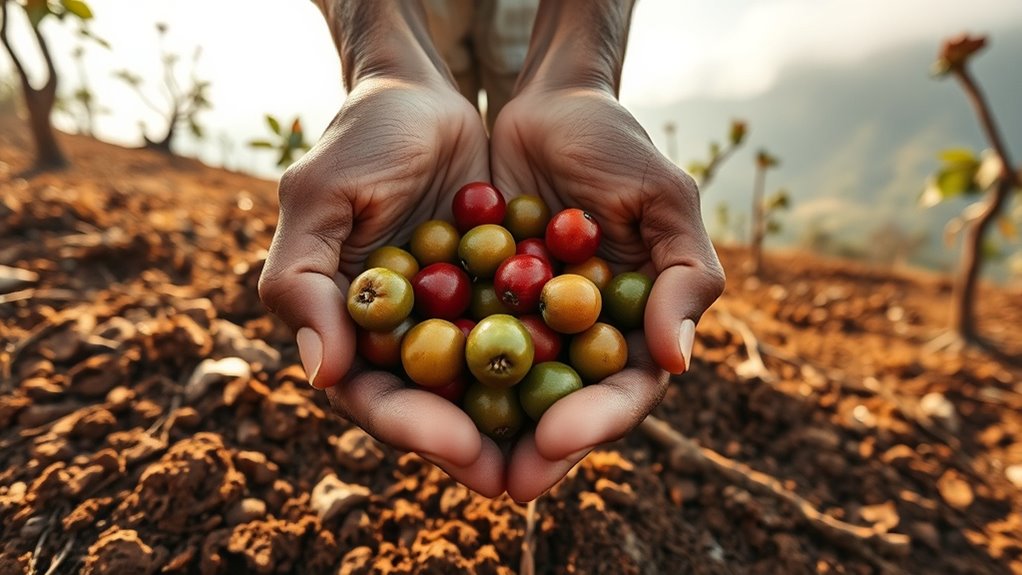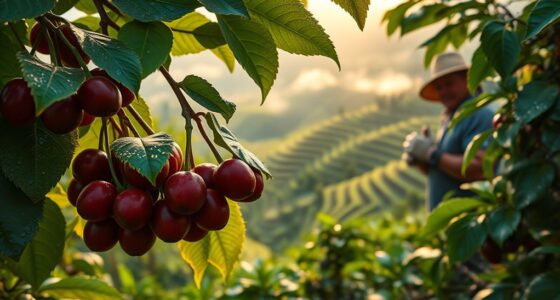Climate change is shrinking traditional coffee-growing areas and creating unpredictable weather, which makes farming more difficult. As temperatures rise and rainfall patterns shift, farmers face lower yields, crop diseases, and weather-related damage. This results in economic hardships and threatens the long-term sustainability of their livelihoods. The future of coffee is uncertain, but understanding these changes can help you see how farmers are adapting—and why this matters to you too.
Key Takeaways
- Climate change reduces suitable land for coffee cultivation, decreasing yields and threatening farmers’ livelihoods worldwide.
- Increased disease susceptibility and altered bean quality negatively impact coffee flavor and market value.
- Unpredictable weather patterns cause crop stress, disrupt harvests, and shift traditional growing seasons.
- Traditional coffee-growing regions are shrinking, with some areas becoming unsuitable while others temporarily benefit.
- Reduced supply and increased market volatility lead to higher prices, economic hardship, and livelihood threats for coffee farmers.

Climate change is profoundly threatening coffee production worldwide, directly impacting the crops you enjoy every day. As temperatures rise and weather patterns become more unpredictable, the land suitable for growing coffee is shrinking. You mightn’t notice it at first, but the areas where coffee plants thrive are decreasing, forcing farmers to contend with less ideal land. This leads to lower yields, as coffee plants experience increased stress from fluctuating temperatures and irregular rainfall. Farmers face a double challenge: not only do their harvests decrease, but the quality of their coffee also suffers, compounding economic hardships.
Climate change reduces coffee yields and quality, threatening farmers’ livelihoods worldwide.
Smallholder farmers, who rely heavily on coffee as their main income, find themselves in a precarious position, struggling to support their families as yields decline and market stability diminishes.
The impact on coffee quality is also noteworthy. Climate change makes coffee plants more vulnerable to diseases like fungal infections, which can wipe out entire crops if not managed properly. Changes in temperature and CO2 levels alter the beans’ nutritional content, potentially reducing their quality and changing their flavor profiles. Inconsistent weather conditions result in unpredictable harvest timings, making it difficult for farmers to plan and maintain steady quality.
Regional flavors, which have historically defined different coffee-producing areas, risk fading away as climate conditions shift away from their ideal ranges. This variability creates challenges for quality control, as farmers and processors struggle to produce uniform products, leading to market uncertainty.
Weather patterns are becoming more erratic, with temperature variability causing plants to face stressful conditions, sometimes too hot or too cold for ideal growth. Precipitation changes threaten to cause both droughts and waterlogging, which damage coffee plants and disrupt their development.
Extreme weather events like floods and droughts are becoming more frequent, often destroying crops and infrastructure. These disruptions make it harder to predict harvest times, forcing farmers to adapt quickly to changing conditions. Traditional growing seasons are shifting, and the timing of flowering and fruiting no longer aligns with historical patterns, complicating planning and management.
On a global scale, the coffee belt—the region around the equator suitable for coffee cultivation—is shrinking. Some areas outside the traditional belt, like parts of China, are becoming more suitable for coffee farming, but overall, the global supply is expected to decline considerably by mid-century.
This reduction threatens the stability of the coffee industry, potentially leading to shortages and increased prices. Regional productivity shifts mean some areas may temporarily benefit, but the overall picture remains bleak. The loss of traditional growing regions and the decline in global supply threaten the industry’s future and the livelihoods of millions of farmers.
As supply decreases, prices will likely rise, making coffee less affordable for consumers and increasing market volatility. For farmers, the economic and social impacts are profound, with many facing the real possibility of losing their livelihoods altogether due to climate change’s relentless march.
Frequently Asked Questions
How Are Coffee Farmers Adapting to Changing Climate Conditions?
You’re likely adapting by diversifying crops to boost resilience and income. You plant shade trees to regulate temperature and switch to climate-resistant coffee varieties.
Adjusting planting dates helps avoid extreme weather, while improving soil health with cover cropping supports sustainability.
You may also use weather forecasts and smart farming tools to make informed decisions. These strategies help you cope with changing conditions, ensuring your farm’s future stability.
What New Coffee Varieties Are Resistant to Climate Impacts?
You’re probably curious about new coffee varieties that resist climate impacts. Companies like Nestlé develop climate-resilient options, such as the Star 4 Arabica, which boosts yields and cuts carbon footprints.
F1 hybrids are also promising, combining traits for better resistance and productivity.
Wild species offer genetic traits that help create tougher, adaptable plants. These innovations aim to secure your coffee supply despite environmental challenges.
How Does Climate Change Affect Coffee Quality and Flavor?
You might notice that climate change impacts coffee quality and flavor considerably. Rising temperatures can cause beans to become more bitter, while cooler conditions may enhance complexity.
Changes in water availability affect bean development, reducing overall quality. Altitude and light exposure shifts influence flavor profiles, and altered nutrient levels can diminish aroma.
To adapt, you need to implement management strategies like shade control, water management, and selecting resilient varieties.
What Financial Support Options Are Available for Affected Farmers?
You have several financial support options available to help you adapt to changing conditions. Programs like the AROMA initiative and Green Climate Fund grants provide funding for climate-resilient practices.
Private companies, such as Starbucks, also offer financing support. Additionally, international guides and government collaborations can assist you in accessing green funding.
These resources aim to improve your farm’s sustainability, boost productivity, and secure your livelihood amid climate challenges.
Are There International Initiatives to Help Coffee-Producing Regions?
You wonder if international efforts exist to aid coffee regions. Yes, they do. These initiatives span multiple countries, focusing on sustainable practices and resilience.
They promote agroforestry, develop climate-resistant crops, and improve supply chains. Funding comes from public-private partnerships, international bodies, and climate funds.
Conclusion
So, even if you think your coffee choices don’t matter, they do. By supporting sustainable farms and reducing your carbon footprint, you help protect these farmers and their crops from climate change’s harsh effects. It’s easy to feel powerless, but small actions add up. Together, we can make a difference—ensuring future generations still enjoy their morning brew. Your choices today can help coffee farmers survive and thrive despite a changing climate.









